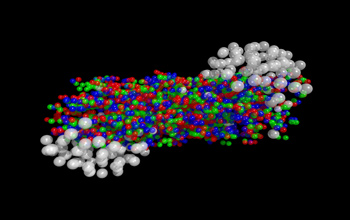Multimedia Gallery
Heavy-ion Collision Producing Quark-gluon Plasma
An artistic conception of a heavy-ion collision producing quark-gluon plasma. Using TeraGrid resources, a group of scientists calculated key properties of quark-gluon plasma at a resolution previously unattainable.
Immediately after the big bang, the early universe had no stars, planets or galaxies that we see today. Instead, it began as a hot plasma mixture of quarks and gluons that eventually cooled and condensed into the protons and neutrons that formed the heavenly bodies we are so familiar with.
Physicists at CERN (the European Center for Nuclear Research) are conducting experiments involving collisions of heavy nuclei to temporarily recreate that primordial quark-gluon plasma and see how it may have cooled and condensed. [Research supported by National Science Foundation grants PHY 04-56556, PHY 05-55235, PHY 04-56691, PHY 05-55243, PHY 06-09852, PHY 05-55234 and PHY 05-55397.] (Date of Image: June 2008)
Credit: This image is reproduced with permission from the press office at CERN (European Center for Nuclear Research), Geneva, Switzerland
See other images like this on your iPhone or iPad download NSF Science Zone on the Apple App Store.
Images and other media in the National Science Foundation Multimedia Gallery are available for use in print and electronic material by NSF employees, members of the media, university staff, teachers and the general public. All media in the gallery are intended for personal, educational and nonprofit/non-commercial use only.
Images credited to the National Science Foundation, a federal agency, are in the public domain. The images were created by employees of the United States Government as part of their official duties or prepared by contractors as "works for hire" for NSF. You may freely use NSF-credited images and, at your discretion, credit NSF with a "Courtesy: National Science Foundation" notation.
Additional information about general usage can be found in Conditions.
Also Available:
Download the high-resolution JPG version of the image. (1.2 MB)
Use your mouse to right-click (Mac users may need to Ctrl-click) the link above and choose the option that will save the file or target to your computer.

